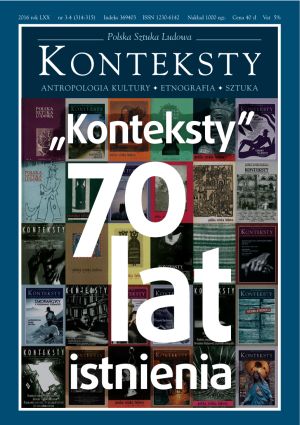Wycinanka żydowska. Obraz i słowo, tradycja i nie-tradycja
Jewish Paper Cutting. Image and Word, Tradition and Non-tradition
Author(s): Monika KrajewskaSubject(s): Fine Arts / Performing Arts, Jewish studies
Published by: Instytut Sztuki Polskiej Akademii Nauk
Keywords: Jewish culture; paper cutting; handcraft
Summary/Abstract: The authors of Jewish ritual art did not find the mere image satisfactory and upon numerous occasions introduced texts – Biblical verses, the words of prayers, and blessings – for the purpose of supplementing ornaments and symbols. Suitable examples may be found in, i.a. painted decorations of synagogues, embellished Torah scrolls, embroidered curtains of the ark containing scrolls, matsevah bas-reliefs or papercuts. In what manner does the image correspond to the text? Certain texts are devoid of corresponding illustrations some are illustrated directly, and some visual arts motifs are not accompanied by a text, but it is still possible to decipher inspirations borrowed from a concrete fragment of the Torah, the Talmud, or Midrash literature. The presence of verses in the case of visual art depictions facilitates the interpretation of their symbolic meaning whenever we are dealing with an ambiguous symbol.This subtle game played with the image and the word has inspired Jewish artists from the distant past to this very day. Take the example of the Jewish papercut, which flourished in particular in nineteenth-century Eastern Europe. From their earliest schooling the authors of such papercuts were familiar with the Torah, the Talmud, and other exegetic texts. Their works fulfilled assorted functions in ritual life as well as within the annual and life cycle, and calligraphic texts depended upon such purposes.When the author of this essay became interested in Jewish paper cutting she was enthralled with the manner in which folk artists expressed diverse contents by means of lacy paper images that did not observe the principles of proportion and perspective or the law of gravity. She regards their works as an inspiration, albeit by no means the sole one, and derives assorted motifs also from Jewish tradition outside the canon of the papercuts of old as well as from her own experiences. This approach is reflected in the I Seek Paradise, Dybbuk, and Burning series, works combining frottages from matsevah bas-reliefs with the papercut, and the Tatras and Psalms series. The author perceives the mountains as a place where the Psalms and the elements meet. Here beauty and awe are so powerful that they are equalled only by Biblical comparisons and blessings said while viewing imposing summits or lightening or hearing the sound of thunder: “Blessed are You, Hashem, our God, King of the universe, for His strength and His power fill the universe”. This is why in this particular series impressions generated by the world of the mountains are collated with verses of the Psalms and other Hebrew religious texts.The Tatras and Psalms exhibition is presented at the Museum of Zakopane Style at Villa Koliba, a branch of the Tatra Museum; its opening accompanied an anthropological conference organised by the editors of the quarterly “Konteksty” and the Residents of Zakopane in Search for Identity Foundation.
Journal: Konteksty
- Issue Year: 314/2016
- Issue No: 3-4
- Page Range: 391-399
- Page Count: 9
- Language: Polish
- Content File-PDF

